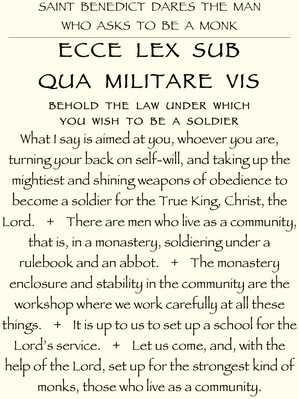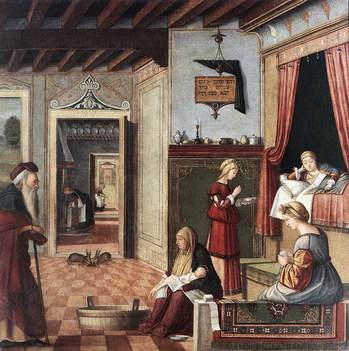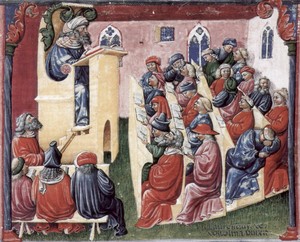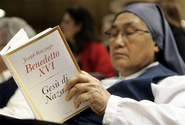New Abbot General of the Trappists
Dom Eamon Fitzgerald, Abbot of Mount Melleray (County Waterford, Ireland) has been canonically and regularly elected as abbot general of the Order of Cistercians of the Strict Observance. In 2007, Dom Eamon was re-elected for his 4th 6-year term abbot of his abbey; the new abbot general was born in 1945. Dom Eamon succeeds Dom Bernardo who has served for the last 18 years as abbot general.
According to the statistics of January 1, 2008, there are 2,185 monks and 1,782 nuns, for a total of 3,967 persons living in 47 different countries. In context the Trappists are canonically speaking, a monastic Congregation which at present unites 97 monasteries of monks and 72 of nuns.
May God grant many fruitful years to Abbot Eamon!
Nativity of the Blessed Virgin Mary
Let us meditate on the most honorable birth of the glorious Virgin Mary, who has attained the dignity of motherhood without losing the purity of maidenhood.
(Magnificat antiphon)
|
Joye in the risinge of our orient starr, The patriark and prophettes were the floures For God, on Earth, she is the royall throne,
Robert Southwell (1560-1595) |
Pope Benedict Prepares for the 12th Synod of Bishops on the Word of God
Today the press office of the Holy See published the names of those the Pope asked to
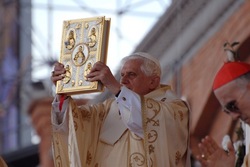 assist the work of the 12th Ordinary General Assembly of the Synod of Bishops being held in Rome October 5-26, 2008. The Synod will be dealing with the topic of “The Word of God in the Life and Mission of the Church.”
assist the work of the 12th Ordinary General Assembly of the Synod of Bishops being held in Rome October 5-26, 2008. The Synod will be dealing with the topic of “The Word of God in the Life and Mission of the Church.”
Pope Benedict’s Janaury 21st address to attending the general meeting for the Synod is here. In the address, the Holy Father says: “Among the Ecclesial Community’s many and great duties in today’s world, I emphasize evangelization and ecumenism. They are centred on the Word of God and at the same time are justified and sustained by it. As the Church’s missionary activity with its evangelizing work is inspired and aims at the merciful revelation of the Lord, ecumenical dialogue cannot base itself on words of human wisdom (cf. I Cor 2: 13) or on neat, expedient strategies, but must be animated solely by constant reference to the original Word that God consigned to his Church so that it be read, interpreted and lived in communion with her.”
On Sunday October 5, at 9:30 a.m., in the Basilica of St. Paul’s Outside-the-Walls, Pope Benedict will open the Synod.
The list of the Ordinary members with the assistance of experts and auditors is extensive and likely to be meaningless for many but there are some names that we ought to raise an eyebrow and say, “Well….” Of interest to me and perhaps to you are the following:
-Marc Cardinal Ouellet, P.S.S.
–Bishop Vincenzo Paglia, Bishop of Terni-Narni-Amelia, Pres. of the Catholic Biblical Federation
-Very Rev’d Fr. Adolfo Nicolás, S.J., Superior General of the Society of Jesus
-Rev’d Fr. Julián Carrón, President of Communion and Liberation
-Rev’d Fr. Peter Damian Akpunonu, Mundelein Seminary, Mundelein, IL
-Rev’d Fr. Enzo Bianchi, Prior of the Monastic Community of Bose, Italy
-Rev’d Sr. Sara Butler, M.S.B.T., Professor of Dogmatic Theology, St. Joseph Seminary, NY
-Rev’d Fr. Juan Javier Flores, O.S.B. Pres. of the Pontifical Liturgical Institute, Rome
-Rev’d Fr. Stephen F. Pisano, S.J. Rector of the Pontifical Biblical Institute (from the USA)
-Rev’d Fr. Marko Rupnik, S.J., Director of the Ezio Aletti Center for Studies & Research, Rome
-Rev’d Sr. Germana Strola, O.C.S.O., Trappist nun of the Vitorchiano Abbey, Italy
-Rev’d Fr. Cyril Vasil, S.J., Rector of the Pontifical Oriental Institute, Rome
-Rev’d Mons. Timothy Verdon, Professor of Sacred Art, Theological Faculty of Central Italy, Florence (from the USA)
-Prof. Michael Waldstein, Professor of NT, International Theological Institute for Studies on Marriage and Family, Gaming, Austria (citizen of the USA & Austria)
Auditors
-Carl Anderson, Supreme Knight of the Knights of Columbus (from the USA)
-Luis F. Figari, Superior General of the Sodalitium Vitae Christianae (from Peru)
-Abbot Michel Jorrot, O.S.B., Abbey of Clervaux (from Luxemburg)
-Rev’d Mother Clare Millea, A.S.C.J., Superior General of the Apostles of the Sacred Heart (from the USA)
-Andrea Riccardi, Founder of the Community of Sant’Egidio (from Italy)
-Maria Voce, Pres. Of the Focolari Movement (from Italy)
Interesting to note that there are no bishops from the USA among the Ordinary members of the Synod. Plus, a number of the experts already sit on the International Theological Commission which is under the auspices of the CDF. One can also appreciate the presence of the ecclesial movements participating in the Synod!
First Friday: Devotion to the Cross & the Sacred Heart of Jesus
 The devotion to the Sacred Heart also reminds us that Jesus gave himself “with all his heart,” that is gladly and with enthusiasm. So we are told that good is to be done with joy, because “there is more joy in giving than in receiving” (Acts 20:35) and “God loves a cheerful giver” (2 Corinthians 9:7). Nevertheless that does not derive from a simple human intention but is a grace that Christ himself gains for us, it is a gift of the Holy Spirit that makes all things easy and sustains us on our daily path, in trials and difficulties also. (Cardinal Carlo Maria Martini, S.J., 30 Days, August 2006)
The devotion to the Sacred Heart also reminds us that Jesus gave himself “with all his heart,” that is gladly and with enthusiasm. So we are told that good is to be done with joy, because “there is more joy in giving than in receiving” (Acts 20:35) and “God loves a cheerful giver” (2 Corinthians 9:7). Nevertheless that does not derive from a simple human intention but is a grace that Christ himself gains for us, it is a gift of the Holy Spirit that makes all things easy and sustains us on our daily path, in trials and difficulties also. (Cardinal Carlo Maria Martini, S.J., 30 Days, August 2006)
Blessed Teresa of Calcutta
Before you speak, it is necessary for you to listen,
for God speaks in the silence of the heart.
(August 26, 1910 – September 5, 1997)
O God, who called the virgin Blessed Teresa
to respond to the love of your Son thirsting on the cross
with outstanding charity to the poorest of the poor,
grant us, we beseech you, by her intercession,
to minister to Christ in his suffering brothers and sisters.
Remember, Lord, Father Joseph Linck
Remember, Lord, those who have died … especially the Reverend Father Joseph Charles Linck, whom today you have called to you from this life …”
Today, in Trumbull, Connecticut, the Church mourned the passing of Father Joseph
 Linck, 43, who succumbed to cancer last week. The Most Reverend William Lori, Bishop of Bridgeport, celebrated the Sacrifice of the Mass with the Order of Christian Burial for Father Linck. About 125 priests concelebrated the Mass.
Linck, 43, who succumbed to cancer last week. The Most Reverend William Lori, Bishop of Bridgeport, celebrated the Sacrifice of the Mass with the Order of Christian Burial for Father Linck. About 125 priests concelebrated the Mass.
Please pray for the repose of the soul of Father Linck and for the Diocese of Bridgeport. In your charity, please keep his parents and friends in prayer. Father Linck was a very kind man, talented and a man of the Church; from personal experience I can say he was a man of good humor and compassion for human nature. This summer, two young-ish priests died, Linck and Fitzpatrick, both good friends. So, a prayer for vocations would be good, too.
May his memory be eternal.
Catholic Underground NYC: September 6
The Catholic Underground is meeting this Saturday, September 6th, at
Our Lady of Good Council Church
230 East 90th Street
New York, NY 10128
7:30 – 10:30 p.m.
Parking: Parking garage available, $10 a night with Catholic Underground stamp
The musician for Saturday is Vince Scheuerman.
About the evening Underground
Catholic Underground ©, a.k.a. CU, is a cultural apostolate of the Franciscan Friars of
 the Renewal. It is a direct response to a call that began with Pope John Paul II, and is continued by Pope Benedict XVI. JPII said that because the Gospel lives in conversation with culture, we must be fearless in crossing the cultural threshold of the communication and information revolution now taking place.
the Renewal. It is a direct response to a call that began with Pope John Paul II, and is continued by Pope Benedict XVI. JPII said that because the Gospel lives in conversation with culture, we must be fearless in crossing the cultural threshold of the communication and information revolution now taking place.
Watch this video clip to get a better sense of what’s being proposed.
The first part of the evening is Eucharistic adoration, and begins with Vespers (Evening Prayer). This is the universal prayer of the Church – prayed by the Catholics throughout the world in every time zone and in every language. After Vespers, there is a time of simple praise. This provides a window for each person to personally encounter Jesus Christ. The beauty of the darkened Church illumined by candles helps us enter the mystery of our Lord’s presence in the Eucharist. The holy hour ends with solemn Benediction.
The second part showcases Catholic artists. Here we experience the “new evangelization”. The Underground includes music, poetry, visual art, dancers, film, drama, etc.
We end our evening as we began, with the prayer of the Church. Compline (Night Prayer) is simple and beautiful. It concludes with a hymn to Our Lady, Daughter Zion. Mother of the New Jerusalem.
Newman scholar clarifies questions of Cardinal’s sexuality
Some people would trash even the good name of the dead to get media attention on their agenda. In this case, it seems as though the homosexual lobbyists are trying to make more of a good friendship than what really was there. That is, questions about Cardinal Newman’s sexuality, that he was same sex attracted, are surfacing with the goal of derailing the process of beatification/canonization. London’s Daily Mail published an article questioning the facts and the Catholic News Agency published this article. Father Kerr’s L’Osservatore Romano article follows; it was published today in the weekly English edition.
CARDINAL JOHN HENRY NEWMAN’S EXHUMATION OBJECTORS
Healthy manhood at the service of the Kingdom
Recently various newspapers have published articles on Venerable John Henry Newman, sowing doubts about his sexual inclination. The following is a clarification by Prof. Ian Ker, an eminent Newman scholar and Oxford University Professor.
Professor Ian Ker
Oxford University, England
The exhumation of Venerable John Henry Newman’s body from his grave has led to calls in particular from the homosexual lobby that he should not be separated from his great friend and collaborator Fr Ambrose St John, in whose grave Newman is buried in accordance with his own specific wishes.
The implication of these protests is clear: that Newman wished to be buried with his
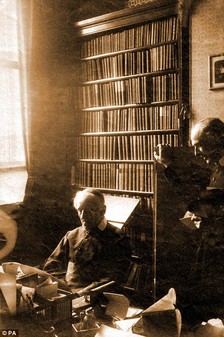 friend because, although no doubt chaste and celibate, nevertheless he had more than simply friendly feelings for St John.
friend because, although no doubt chaste and celibate, nevertheless he had more than simply friendly feelings for St John.
However, if wanting to be buried in the same grave as someone else indicates some kind of sexual love for the other person, then C.S. Lewis’ brother Warnie, who is buried in the same grave in accordance with both brothers’ wishes, must have had incestuous feelings for his brother.
Or again, G.K. Chesterton’s devoted secretary, Dorothy Collins, whom he and his wife regarded as a daughter, while thinking it presumptuous to ask to be buried in the same grave as the Chestertons, nevertheless directed that she be cremated and that her ashes should be buried in the same grave. Does this mean that she had more than filial feelings for one or both of her employers?
Ambrose St John was an extremely close friend of Newman. He had devoted himself for 30 years to the service of Newman, even asking if he might take a vow of obedience to him at his Confirmation, a request that was, of course, refused.
Newman blamed himself for his death, having asked him to translate the German theologian Joseph Fessler’s important book on infallibility in the wake of the First Vatican Council, a last labour of love that had proved too much for him, overworked as he already was.
In his dark last days as an Anglican, Newman said that Ambrose St John had come to him “as Ruth to Naomi”. After joining Newman’s semi-monastic community at Littlemore outside Oxford, he had remained as Newman’s closest supporter all through the difficulties of founding the Oratory of St Philip Neri in England and all through Newman’s many subsequent trials and tribulations as a Catholic.
In his Apologia pro Vita sua, Newman “with great reluctance” mentions that at the time of his first religious conversion when he was 15 he became convinced that “it would be the will of God that I should lead a single life”.
For the next 14 years, “with the break of a month now and then”, and then continuously, he believed that his “calling in life would require such a sacrifice”.
Needless to say, there were no “civil partnerships” between men then in what was still a Christian country where homosexual activity was punishable by imprisonment and was universally regarded as immoral. Newman, of course, is talking about marriage with a woman and the sacrifice that celibacy involved.
The only reason it could have been a sacrifice was because like any normal man Newman wished to get married. But, although not belonging to a church where celibacy was the rule or even the ideal, Newman, steeped in Scripture as he was, knew the words of our Lord: “there are eunuchs who have made themselves that way for the sake of the kingdom of heaven”.
Twenty five years after his youthful embrace of celibacy, we find Newman counting the cost, at the conclusion of the extraordinary account he wrote of his near fatal illness in Sicily in 1833: “The thought keeps pressing on me, while I write this, what am I writing it for?… Whom have I, whom can I have, who would take interest in it?… This is the sort of interest which a wife takes and none but she – it is a woman’s interest – and that interest, so be it, shall never be taken in me…. And therefore I willingly give up the possession of that sympathy, which I feel is not, cannot be, granted to me. Yet, not the less do I feel the need of it”.
In these moving sentences, written while he was still a clergyman of the Church of England and fully entitled to marry, we see Newman’s total commitment to the life of virginity to which he felt unmistakably called, but yet we can also feel the deep pain he experienced in sacrificing the love of a woman in marriage.
Finally, what should be said to those who think Newman’s wishes should be honoured and that Ambrose St John’s remains should be removed with his?
Throughout his life as a Catholic, Newman always insisted that whatever he wrote he wrote under the correction of Holy Mother Church. That was his constant refrain. If the Church decrees that his remains should be removed to a church, then Newman’s undoubted response would be that of his last testament, like everything else he wrote, he wrote under correction of higher authority.
And if that higher authority decrees that his body be removed and that of his friend left, then Newman would say without hesitation, “so be it”.
Are you fit for mission? Bishop O’Donoghue is asking & the Church wants to know
The other day Bishop Patrick O’Donoghue of the Diocese of Lancaster, England, released a
 92-page document which is seen as highly critical of the Church in England since the Second Vatican Council. The Catholic Herald carries the story.
92-page document which is seen as highly critical of the Church in England since the Second Vatican Council. The Catholic Herald carries the story.
Several areas of concern are addressed by Bishop O’Donoghue: hope in Christ, Vatican II, Catholic identity, the work of the Trinity in our lives and in the Church, the role of the sacred. Liturgy, Divine Revelation’s hold on us, dogma, and various other points concerning society and culture.
The bishop’s document, “Fit for Mission?” seems insightful and is worth the time reading. The concerns that Bishop O’Donoghue has for the Church in his diocese, indeed for all of England are similar for those of us who live in North Americans. For that matter, they are the same concerns Monsignor Luigi Giussani had in the 1950’s Italy and later articulated by Popes John Paul II and Benedict XVI. Namely, do you have a personal relationship with Christ, do you adhere to the objectivity of the Church, is faith a moralism or a way of knowing, living and loving, does your destiny really matter to you?
